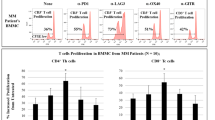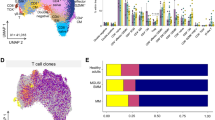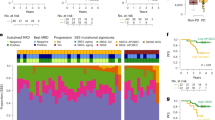Abstract
Persons with myeloma were randomized to receive an anti-TIGIT (T cell immunoreceptor) or anti-LAG3 (lymphocyte activation gene) antibody followed by combination with pomalidomide and dexamethasone (NCT04150965). Primary and secondary endpoints were safety and efficacy, respectively. Therapy was well tolerated without dose-limiting toxicity. Durable clinical responses were observed in both the anti-TIGIT(three of six participants) and the anti-LAG3 (two of six participants) arms. Anti-LAG3 responders had higher naive cluster of differentiation 4 (CD4)-positive T cells and lower programmed cell death protein 1-positive effector T cells. Anti-TIGIT responders had higher CD226 expression, natural killer cell activation and lower CD112 expression. These data demonstrate the clinical activity of TIGIT–LAG3 blockade and identify pathway-specific response correlates in myeloma.
This is a preview of subscription content, access via your institution
Access options
Access Nature and 54 other Nature Portfolio journals
Get Nature+, our best-value online-access subscription
$32.99 / 30 days
cancel any time
Subscribe to this journal
Receive 12 digital issues and online access to articles
$119.00 per year
only $9.92 per issue
Buy this article
- Purchase on SpringerLink
- Instant access to full article PDF
Prices may be subject to local taxes which are calculated during checkout


Similar content being viewed by others
Data availability
All other data supporting the findings of this study are available from the corresponding author on reasonable request. Source data are provided with this paper.
References
Dhodapkar, M. V., Krasovsky, J. & Olson, K. Proc. Natl Acad. Sci. USA 99, 13009–13013 (2002).
Dhodapkar, M. V. Am. J. Hematol. 98, S4–S12 (2022).
Chen, D. S. & Mellman, I. Immunity 39, 1–10 (2013).
Sharma, P. & Allison, J. P. Sci. Transl. Med. 14, eadf2947 (2022).
Lesokhin, A. M. et al. J. Clin. Oncol. 34, 2698–2704 (2016).
Costa, F., Das, R., Kini Bailur, J., Dhodapkar, K. & Dhodapkar, M. V. Front. Immunol. 9, 2204 (2018).
Guillerey, C. et al. Blood 132, 1689–1694 (2018).
Bailur, J. K. et al. JCI Insight 5, e127807 (2019).
Alrasheed, N. et al. Clin. Cancer Res. 26, 3443–3454 (2020).
Minnie, S. A. et al. J. Clin. Investig. 133, e157907 (2023).
Jing, W. et al. J. Immunother. Cancer 3, 2 (2015).
Dimopoulos, M. A. et al. J. Clin. Oncol. 41, 568–578 (2023).
Johnston, R. J. et al. Cancer Cell 26, 923–937 (2014).
Ardolino, M. et al. Blood 117, 4778–4786 (2011).
Rotte, A., Sahasranaman, S. & Budha, N. Biomedicines 9, 1277 (2021).
Maruhashi, T. et al. Nat. Immunol. 19, 1415–1426 (2018).
Boes, M. et al. Nature 418, 983–988 (2002).
Bar, N. et al. JCI Insight 5, e129353 (2020).
Oh, S. A. et al. Nat. Cancer 1, 681–691 (2020).
Ascierto, P. A. et al. J. Clin. Oncol. 41, 2724–2735 (2023).
Acknowledgements
M.V.D. is supported in part by funds from the National Institutes of Health (NIH; R35CA197603), the Paula and Rodger Riney Foundation and a Specialized Center of Research award from the Leukemia and Lymphoma Society. K.M.D. is supported in part by funds from the NIH (CA238471 and AR077926). A.M.L. is supported in part by funds from the NIH (P30 CA008748). We also acknowledge the Winship Immune monitoring resource supported by funding from the NIH (P30 CA138292). We thank the members of the data safety monitoring board for this trial and clinical research staff at the participating institutions.
Author information
Authors and Affiliations
Contributions
S.R., A.M.L., B.P., J.L.K., M.P., N.B., R.V., M.M., K.W. and H.J.C. performed clnical research and data analysis and reviewed the paper. D.B.D. and M.I.A. performed the correlative studies. K.M.D. and M.V.D. designed and supervised the project and the correlative studies and wrote the paper. All authors reviewed and approved the paper.
Corresponding authors
Ethics declarations
Competing interests
M.V.D., consulting and advisory board for BMS, Lava Therapeutics and Sanofi. R.V., research support from BMS and Takeda; honoraria from Janssen, BMS, Sanofi, Karyopharm, Pfizer, GSK and Legend. J.L.K., consulting for BMS, Sanofi, Abbvie and Incyte. B.P., research funding from BMS; advisory boards for Janssen and Abbvie. N.B., consulting and advisory board for Janssen, Sanofi, Pfizer, Abbie and BMS; speaker bureau for Janssen, BMS and Pfizer; research support from Karyopharm, Amgen, BMS and Janssen. H.J.C., research support from Genentech, Roche, BMS and Takeda. H.J.C., K.W. and M.M. are employees of the MM Research Foundation. A.M.L., advisory roles for Pfizer, Arcellx and Janssen; research support from Pfizer and BMS; licenses and royalties from Caprion.
Peer review
Peer review information
Nature Cancer thanks P. Leif Bergsagel, Maximilian Merz and the other, anonymous, reviewer(s) for their contribution to the peer review of this work.
Additional information
Publisher’s note Springer Nature remains neutral with regard to jurisdictional claims in published maps and institutional affiliations.
Extended data
Extended Data Fig. 1 TIGIT Receptor occupancy following anti-TIGIT or anti-LAG3 antibody therapy.
a. TIGIT receptor occupancy in bone marrow immune cells from biospecimens obtained from responding (Resp) or non-responding (NR) patients before (PreRx) after first (C1) or second cycle (C2) of therapy with anti-TIGIT antibody. Data points represent biologically independent samples (TIGIT Resp PreRx: n = 3, TIGIT Resp C1: n = 2, TIGIT Resp C2: n = 3; TIGIT NR PreRx: n = 3; TIGIT NR C1: n = 1, TIGIT NR C2: n = 2). b. TIGIT receptor occupancy in circulating immune cells from biospecimens obtained from responding (Resp) or non-responding (NR) patients before (PreRx) after first (C1) or second cycle (C2) of therapy with anti-Lag3 antibody. Data points represent biologically independent samples (LAG3 Resp PreRx: n = 4, LAG3 Resp C1: n = 6, LAG3 Resp C2: n = 2; LAG3 NR PreRx: n = 6; LAG3 NR C1: n = 10, LAG3 NR C2: n = 3). c. TIGIT receptor occupancy in bone marrow immune cells from biospecimens obtained from responding (Resp) or non-responding (NR) patients before (PreRx) after first (C1) or second cycle (C2) of therapy with anti-LAG3 antibody. Data points represent biologically independent samples (LAG3 Resp PreRx: n = 2, LAG3 Resp C1: n = 2, LAG3 Resp C2: n = 2; LAG3 NR PreRx: n = 4; LAG3 NR C1: n = 5, LAG3 NR C2: n = 2). Box plots represent median with Q1-Q3 and error bars as min-max. MMI: median metal intensity.
Extended Data Fig. 2 Receptor occupancy without target depletion following anti-TIGIT antibody therapy.
a. Representative data showing TIGIT staining in peripheral blood CD8 T cell subsets either before (TIGIT PreRx) or after (TIGIT Post C1) therapy with anti-TIGIT antibody. Naïve (CCR7 + RO-), central memory (CM; CCR7 + RO + ), effector memory (EM; CCR7-RO + ) and terminal effectors (Term EFF; CCR7-RO-) CD8 T cells. b. Proportions of naïve, CM, EM and Term EFF CD8 T cells in blood and bone marrow biospecimens obtained from patients pre (TIGIT PreRx) and post cycle 1 (TIGIT Post C1) following therapy with anti-TIGIT antibody. Data points represent biologically independent samples. Blood (TIGIT PreRx: n = 8, TIGIT Post C1: n = 17). Bone marrow (TIGIT PreRx: n = 3, TIGIT Post C1: n = 3). No differences were seen in proportions of circulating or bone marrow CD8 cell subsets before or after therapy with anti-TIGIT antibody (p=non-significant, 2 tailed Mann Whitney; naïve PreRx vs Post C1, CM PreRx vs Post C1, EM PreRx vs Post C1 and Term EFF PreRx vs Post C1). Box plots represent median with Q1-Q3 and error bars as min-max. c. Pre-treatment peripheral blood mononuclear cells from a patient on the TIGIT arm were thawed and cultured alone or with autologous plasma from cycle 1 day 15 (C1D15) for one hour. Staining for TIGIT expression on NK, CD8 and regulatory T cells (Treg) was assessed using mass cytometry.
Extended Data Fig. 3 Immune subsets versus response to anti-TIGIT/Lag-3.
a. Proportions of circulating lymphocytes (CD8, CD4, Treg and NK cells) in biospecimens obtained from responding (Resp) or non-responding (NR) patients before treatment (PreRx) or after first (C1) or second cycle (C2) of therapy with anti-TIGIT antibody. Data points represent biologically independent samples (TIGIT Resp PreRx: n = 4, TIGIT Resp C1: n = 7, TIGIT Resp C2: n = 4; TIGIT NR Pre Rx: n = 4; TIGIT NR C1: n = 9, TIGIT NR C2: n = 2). Box plots represent median with Q1-Q3 and error bars as min-max. b, c. Proportions of CD4 subsets; naïve (CCR7 + RO-), central memory (CM; CCR7 + RO + ), effector memory (EM; CCR7-RO + ) and terminal effectors (Term EFF; CCR7-RO-) CD4 T cells in blood and bone marrow biospecimens obtained from responding (Resp) or non-responding (NR) patients before treatment (PreRx) or after first (C1) or second cycle (C2) of therapy with anti-LAG3 antibody. Data points represent biologically independent samples. b. Blood CD4 subsets (LAG3 Resp PreRx: n = 4, LAG3 Resp C1: n = 6, LAG3 Resp C2: n = 2; LAG3 NR PreRx: n = 6; LAG3 NR C1: n = 10, LAG3 NR C2: n = 3). There were higher proportions of circulating naïve CD4 and lower proportions of CM CD4 T cells in patients who responded to anti-LAG3 therapy compared to patients who did not respond. Responder Pre+C1 + C2 compared to non-responder Pre+C1 + C2, 2 tailed Mann Whitney. c. Bone marrow CD4 subsets (LAG3 Resp Pre Rx: n = 2, LAG3 Resp C1: n = 2, LAG3 Resp C2: n = 2; LAG3 NR Pre Rx: n = 4; LAG3 NR C1: n = 5, LAG3 NR C2: n = 2). There were higher proportions of bone marrow naïve CD4 T cells in patients who responded to anti-LAG3 therapy compared to patients who did not respond. Responder Pre+C1 + C2 compared to non-responder Pre+C1 + C2, 2 tailed Mann Whitney. Box plots represent median with Q1-Q3 and error bars as min-max.
Extended Data Fig. 4 Lack of correlation between baseline CD4 T cell subsets and prior daratumumab as last line of therapy in patients on anti-lag-3 arm.
CyTOF was used to assess CD4 T cell subsets (naïve (CCR7 + RO-), central memory (CM; CCR7 + RO + ), effector memory (EM; CCR7-RO + ) and terminal effectors (Term EFF; CCR7-RO-) in pre treatment biospecimens obtained from patients on the Lag-3 arm who did or did not receive prior daratumumab therapy. Data points represent biologically independent samples. a. CD4 T cell subsets in the blood. Data points represent biologically independent samples. Prior Dara: n = 5, no Dara: n = 5. No differences were observed in proportions of circulating CD4 subsets (Naïve, CM, EM, Term EFF) in patients who did or did not receive prior Daratumumab therapy (p=non-significant, 2 tailed Mann Whitney). b. CD4 T cell subsets in the bone marrow. Data points represent biologically independent samples. Prior Dara: n = 3, no Dara: n = 3. No differences were observed in proportions of bone marrow CD4 subsets (Naïve, CM, EM, Term EFF) in patients who did or did not receive prior Daratumumab therapy (p=non-significant, 2 tailed Mann Whitney). Box plots represent median with Q1-Q3 and error bars as min-max.
Extended Data Fig. 5 Correlation of DNAM-1 and CD112 with response to anti-TIGIT or anti-LAG3 therapy.
a. DNAM 1 expression in circulating immune cells from biospecimens obtained from responding (Resp) or non-responding (NR) patients before (PreRx) after first (C1) or second cycle (C2) of therapy with anti-TIGIT antibody. Data points represent biologically independent samples (TIGIT Resp PreRx: n = 4, TIGIT Resp C1: n = 7, TIGIT Resp C2: n = 4; TIGIT NR Pre Rx: n = 4; TIGIT NR C1: n = 9, TIGIT NR C2: n = 2). Statistical test compares post Rx (C1 + C2) specimens from responders (n = 11) and non responders (n = 11) to anti-TIGIT therapy, 2-tailed Mann Whitney. b. CD112 expression in circulating immune cells from biospecimens obtained from responding (Resp) or non-responding (NR) patients before (PreRx) after first (C1) or second cycle (C2) of therapy with anti-TIGIT antibody. Data points represent biologically independent samples (TIGIT Resp PreRx: n = 4, TIGIT Resp C1: n = 7, TIGIT Resp C2: n = 4; TIGIT NR Pre Rx: n = 4; TIGIT NR C1: n = 9, TIGIT NR C2: n = 2). Statistical test compares post Rx (C1 + C2) specimens from responders (n = 11) and non-responders (n = 11) to anti-TIGIT therapy, 2-tailed Mann Whitney. c. DNAM-1 expression in effector memory CD8 + T cells and response to TIGIT blockade. DNAM 1 expression in circulating immune cells from biospecimens obtained from responding (Resp) or non-responding (NR) patients before (PreRx) after first (C1) or second cycle (C2) of therapy with anti-TIGIT antibody. Data points represent biologically independent samples. (TIGIT Resp PreRx: n = 4, TIGIT Resp C1: n = 7, TIGIT Resp C2: n = 4; TIGIT NR Pre Rx: n = 4; TIGIT NR C1: n = 9, TIGIT NR C2: n = 2). Statistical test compares post Rx (C1 + C2) specimens from responders (n = 11) and non-responders (n = 11) to anti-TIGIT therapy, 2-tailed Mann Whitney. d. DNAM-1 expression and response to anti-LAG3. Expression of DNAM-1/CD226 in CD8 and NK cells in blood and bone marrow and correlation with response to therapy in biospecimens from patients treated with anti-LAG3 antibody. Data points represent biologically independent samples; blood (Responder: n = 12, Non-Responder: n:19), bone marrow (Responder: n = 6, Non-Responder: n:11). No difference was observed in DNAM-1 expression on circulating or bone marrow CD8 or NK cells in patients who did or did not respond to anti-LAG3 therapy (p=non-significant 2 Tailed Mann Whitney). e. CD112 expression and response to anti-LAG3. Expression of CD112 in CD8 and NK cells in blood and correlation with response to therapy in biospecimens from patients treated with anti-LAG3 antibody. Data points represent biologically independent samples Data points represent biologically independent samples; blood (Responder: n = 12, Non-Responder: n:19), bone marrow (Responder: n = 6, Non-Responder: n:11). No difference was observed in CD112 expression on circulating or bone marrow CD8 or NK cells in patients who did or did not respond to anti-LAG3 therapy (p=non-significant 2 Tailed Mann Whitney). MMI: median metal intensity. Box plots represent median with Q1-Q3 and error bars as min-max.
Extended Data Fig. 6 Patterns of PD-1 expression in post-treatment T cell subsets in patients receiving anti-LAG-3 therapy.
a. PD-1 expression in bone marrow CD4 and CD8 cell subsets from biospecimens obtained from responding (Resp) or non-responding (NR) patients before (PreRx) after first (C1) or second cycle (C2) of therapy with anti-lag-3 antibody. Data points represent biologically independent samples (LAG3 Resp PreRx: n = 2, LAG3 Resp C1: n = 2, LAG3 Resp C2: n = 2; LAG3 NR PreRx: n = 4; LAG3 NR C1: n = 5, LAG3 NR C2: n = 2). Statistical test compares post Rx (C1 + C2) specimens from responders (n = 4) and non-responders (n = 7) to anti-LAG3 therapy, 2-tailed Mann Whitney. b. PD-1 expression in blood CD4 and CD8 cell subsets from biospecimens obtained from responding (Resp) or non-responding (NR) patients before (PreRx) after first (C1) or second cycle (C2) of therapy with anti-lag-3 antibody. Data points represent biologically independent samples (LAG3 Resp PreRx: n = 4, LAG3 Resp C1: n = 6, LAG3 Resp C2: n = 2; LAG3 NR PreRx: n = 6; LAG3 NR C1: n = 10, LAG3 NR C2: n = 3). Statistical test compares post Rx (C1 + C2) specimens from responders (n = 8) and non-responders (n = 13) to anti-LAG3 therapy, 2-tailed Mann Whitney. Box plots represent median with Q1-Q3 and error bars as min-max. MMI: median metal intensity.
Extended Data Fig. 7 Lack of correlation between PD1 expression and clinical response in patients treated with anti-TIGIT antibody.
a. PD-1 expression in bone marrow CD4 and CD8 cell subsets from biospecimens obtained from responding (Resp) or non-responding (NR) patients before (PreRx) after first (C1) or second cycle (C2) of therapy with anti-TIGIT antibody. Data points represent biologically independent samples (TIGIT Resp PreRx: n = 3, TIGIT Resp C1: n = 2, TIGIT Resp C2: n = 3; TIGIT NR PreRx: n = 3; TIGIT NR C1: n = 1, TIGIT NR C2: n = 2). No differences were seen in the expression of PD1 between responders and non-responders. Statistical test compares post Rx (C1 + C2) specimens from responders (n = 5) and non-responders (n = 3) to anti-TIGIT therapy, 2-tailed Mann Whitney. b. PD-1 expression in blood CD4 and CD8 cell subsets from biospecimens obtained from responding (Resp) or non-responding (NR) patients before (PreRx) after first (C1) or second cycle (C2) of therapy with anti-TIGIT antibody. Data points represent biologically independent samples (TIGIT Resp PreRx: n = 4, TIGIT Resp C1: n = 7, TIGIT Resp C2: n = 4; TIGIT NR Pre Rx: n = 4; TIGIT NR C1: n = 9, TIGIT NR C2: n = 2). No differences were seen in the expression of PD1 between responders and non-responders. Statistical test compares post Rx (C1 + C2) specimens from responders (n = 11) and non-responders (n = 11) to anti-TIGIT therapy, 2-tailed Mann Whitney. Box plots represent median with Q1-Q3 and error bars as min-max. MMI: median metal intensity.
Supplementary information
Supplementary Information
Supplementary Table 1. Supplementary Table 2. Supplementary Table 3. Supplementary Table 4. Supplementary Table 5. Supplementary Table 6. Supplementary Table 7.
Clinical protocol
Clinical protocol and Supplementary Note.
Consort checklist
Consort checklist and Supplementary Note.
Source data
Source Data
Source data for all figures (main and extended data).
Rights and permissions
Springer Nature or its licensor (e.g. a society or other partner) holds exclusive rights to this article under a publishing agreement with the author(s) or other rightsholder(s); author self-archiving of the accepted manuscript version of this article is solely governed by the terms of such publishing agreement and applicable law.
About this article
Cite this article
Richard, S., Lesokhin, A.M., Paul, B. et al. Clinical response and pathway-specific correlates following TIGIT–LAG3 blockade in myeloma: the MyCheckpoint randomized clinical trial. Nat Cancer 5, 1459–1464 (2024). https://doi.org/10.1038/s43018-024-00818-w
Received:
Accepted:
Published:
Issue date:
DOI: https://doi.org/10.1038/s43018-024-00818-w



